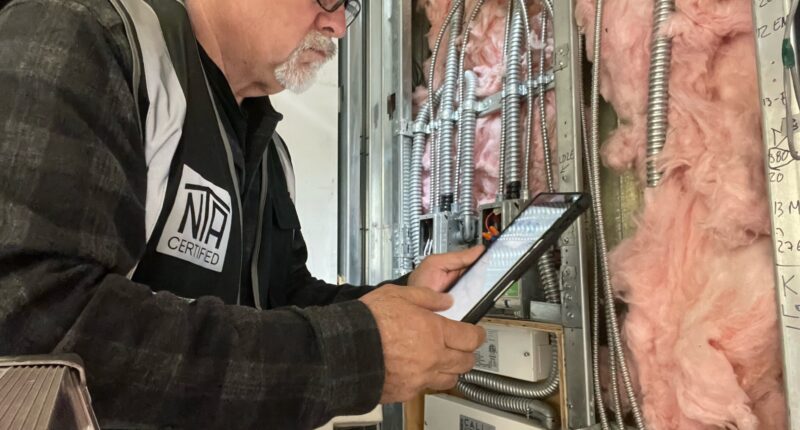The standards for modular and site-built construction are the same, but the process of meeting those standards is a bit different.
- Modular buildings must meet all requirements set by the state building code, including any amendments.
- A majority of states have additional requirements for modular factories. This is to ensure that those factories’ products do, in fact, meet the code.
- The factory must earn certification for each state in which it will place homes. To get that certification it needs to have an effective QA program.
This magazine has pointed out in numerous articles that modular homes and buildings must meet the same code requirements as site-built structures. And we have repeatedly argued that the quality control made possible by building in a factory can actually result in a better product. But just saying that isn’t enough; a lot of builders (understandably) need to see the details to be convinced.
That’s what we’ll do here. To clarify how the modular inspection process works, we spoke with Robert Lee, Director of Inspection Services at ICC NTA, a subsidiary of the International Code Council. He confirmed that, generally speaking, whatever code a state adopts for conventional buildings applies equally to modular buildings in that state.
For example, Louisiana has adopted the 2015 International Residential Code (IRC), Florida the 2018 IRC and North Dakota the 2021 IRC. Those codes apply to both conventional and modular buildings in each of those states.
In addition, some states have amended their state-adopted building code to meet the needs of their unique climate and geography. For example, California has amended its code to have stricter seismic requirements, while Florida’s amendments require higher wind loads. All of these apply to modular construction.

State Modular Programs
That’s not to say there aren’t exceptions for modular. There are. Some states and municipalities have made amendments to their state-adopted codes that impose additional regulations on modular construction.
When a state explicitly addresses modular construction as something distinct from conventional construction in their amendments to the building code, that’s called having a modular program. Currently, 39 states have a modular program.
The intent of these programs is to ensure that modular homes do, in fact, meet the state building codes.
There are requirements for inspectors as well as factories. “For example, Ohio requires modular inspectors to take its state plumbing test and to get an Ohio inspection license. California requires inspectors to take their factory-built housing exam and to have a California inspection license,” Lee says. “South Dakota requires a licensed plumber to be on staff in the factory.”
Lee explains that if there’s not a modular program in the state where the building will be set, then the factory inspectors will typically work directly with the local authorities who have jurisdiction at the building site. They will find out from the local authorities what’s required for the modular building to get a certificate of occupancy.
At the Factory
Most inspections happen at the factory, while some other inspections are done at the site. Who does them? The answer is that it varies by state.
Some states allow third parties, like ICC NTA, to perform factory inspections as well as on-site inspections. Other states have their own officials do on-site inspections, but allow third parties to do factory inspections. Still others do their own on-site and factory inspections inside their own state, but have third parties do inspections in factories that are out-of-state (but whose product will be located in their state).
Lee explains that, sometimes, whether third-party inspections are allowed is a matter of funding or staffing. If a state can’t afford to send inspectors out of state to do factory inspections, or they don’t have enough staff for that to be feasible, it makes sense for them to use a third party.

The Inspection Process
So, while the same standards apply to both conventional and modular construction, the inspection process for modular differs from conventional.
With conventional construction, an inspector visits the site after each phase of the job (foundation, framing, wiring, insulation, etc.) has been completed. And because licensed tradespeople have done the work or have had oversight of it, inspectors usually just do spot checks of the finished product. They don’t need to witness all the framing being done, all the MEP being installed, and so on.
This contrasts with the factory inspection process. Factories usually aren’t required to have licensed tradespeople on staff and so inspectors do need to watch how modules are constructed and how any MEP is installed — and they need to make sure all the work is done to code.
When a new factory starts manufacturing modules, inspectors will typically be there every day, working alongside the factory staff as they build structures and install windows, electrical wire, plumbing, etc. Prior to factory certification, inspectors see every, single module at every stage of manufacture. “We’re in the factory watching every piece of the module go together until it becomes a structure,” Lee says. “Most of our inspectors have licenses so they can inspect the MEP being installed.”
If the inspector sees things that aren’t being installed to code, the inspector will work with the factory to make sure that workers get adequate training and that processes are tweaked to bring the work up to code.
Continuous inspection of every phase of production is (in most states) a temporary situation and only lasts until a factory is certified. How much the frequency and scope of inspections can be reduced after certification varies from state to state.
When a module passes inspection, the inspector will affix, or assign, an insignia to it indicating that it meets or exceeds the building code of the state where the building will be located. (Of course, this isn’t necessarily if the home will be located in the same state as the factory.) It varies by state whether the factory can affix insignias themselves after certification, or whether this must continue being done by the inspector.
QA Programs
Inspectors also help the factory devise and implement a quality assurance (QA) program. In fact, the states that have a modular program won’t certify a factory until it has such a program.
Lee says that when ICC NTA evaluates a factory’s QA program, they look to see that the following seven attributes have been established and that processes have been put in place to ensure they are implemented.
- Production process. The factory must have a detailed description of the work that happens at each stage of production.
- Inspection process. There must be a documented process for recognizing and fixing any failures to conform to state standards.
- Testing program. The factory’s documented inspection processes must include details of how MEP systems are tested to ensure they meet state standards.
- Internal auditing. The factory must have a documented process for finding the source of any failure to conform to a standard, and a process to prevent reoccurrence. (For example, if an electrical junction box wasn’t installed to code, was it an insufficiently trained employee? An error in the design drawings?)
- Training programs. The factory must have a process for the training of new staff and for the ongoing training of existing staff, to ensure that they are capable of manufacturing to the required standards.
- Document control. There must be a process in place to ensure that shop drawings match the approved design drawings.
- Material control. The factory must have a process to ensure that materials coming into the factory meet any required standards, for example, an AAMA (American Architectural Manufacturers Association) certification for windows, or a UL listing for an insulation product.
Lee says that a QA program with these seven attributes would satisfy most states’ modular programs. Once a QA program is functioning well and the factory is consistently manufacturing to state and internal standards, the factory is certified. Once a factory is certified for one state, if the factory later wants to get certified for another state, it will need to be inspected again. But the repeat process is usually quick, Lee says, because there isn’t much difference between various states’ requirements.

Reducing Inspection Frequency
How many inspections are needed varies over time and depends on the effectiveness of the QA program. “In the first few months, we work with staff to help them establish a functioning QA program,” Lee says. Once the QA program is established and functioning well, “Then, at that point, you’re likely to be able to reduce the number of inspections by 20% or 30%, depending on the state.”
The idea is that once a factory is consistently making repeated instances of the same product, it’s no longer necessary to inspect every production stage of every module. The factory certification serves a purpose analogous to on-site trades’ professional licensing. Once that’s done, the inspector can be confident that the factory’s processes will lead to consistent production of modules that satisfy code requirements.
A factory that consistently manufactures the same few module designs (e.g., for hotels or apartment buildings) will generally earn certification more quickly than a factory that manufactures custom single-family homes.
Unsurprisingly, the amount of time it takes for a factory to achieve certification varies. Some factories can perfect some stages of their process quickly, while there are other parts they struggle with. “We’ll maintain 100% inspection of the problematic areas until we get them under control,” Lee says.
After certification, every module still must be inspected at some point during production — either by state inspectors or third-party inspectors like ICC NTA. However, the extent of the inspection varies by state. In some states, inspectors may need to continue to check just a single phase of production.

On-site Inspections
As with conventional construction, the local official having jurisdiction will inspect the foundation. This happens before the modules are set on it.
The local official with jurisdiction will also determine the schedule of when the assembled modules are inspected on-site, which plumbing and electrical connections they want to look at, and so on. Sometimes they do it themselves, sometimes they hire a third party. If ICC NTA does it, Lee says, inspectors will watch all the modules being put together on-site to make sure everything is assembled as designed.
“Work that was done in the factory has already been inspected and approved under the state program — as indicated by the state insignia that’s affixed to every module before it leaves the factory,” Lee says. Although there could be exceptions, such as when a module may have been damaged during transportation or craning, Lee adds that “local officials should not have a need to open up modules or pull anything apart to re-inspect it.”
All photos courtesy of ICC NTA.
Zena Ryder writes about construction and robotics for businesses, magazines, and websites. Find her at zenafreelancewriter.com.












